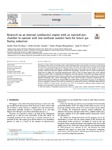Research on an Internal Combustion Engine With an Injected Pre-chamber to Operate With Low Methane Number Fuels for Future Gas Flaring Reduction

Use este enlace para citar
http://hdl.handle.net/2183/30986
A non ser que se indique outra cousa, a licenza do ítem descríbese como Atribución-NoComercial 4.0 Internacional
Coleccións
Metadatos
Mostrar o rexistro completo do ítemTítulo
Research on an Internal Combustion Engine With an Injected Pre-chamber to Operate With Low Methane Number Fuels for Future Gas Flaring ReductionData
2022Cita bibliográfica
ZARDOYA, Ander Ruiz et al. Research on an internal combustion engine with an injected pre-chamber to operate with low methane number fuels for future gas flaring reduction. Energy [en línea]. 2022, 124096. ISSN 0360-5442. Disponible en: doi:10.1016/j.energy.2022.124096
Resumo
[Abstract] Flaring gas is the action of burning waste crude natural gas that is not possible to process or sell during the extraction and processing of oil and gas extraction. However, the surge of the oil and gas (O&G) fields caused an augmentation of flared gas; making society aware of its impact on the planet. To solve this problem, internal combustion engines showed clear advantages. However, there is a lack of information about how to utilize this associated petroleum gas (APG) as fuel for these engines due to its reduced methane number (MN). A methodical investigation about the optimal combustion and design needs for low MN fuels is proposed based on tests conducted in a natural gas engine with an injected pre-chamber ignition technology and a future technology that could replace flaring is proposed. Experiments conducted when using low MN gases showed different misfire limits and knocking margins. A 15% efficiency drop was obtained, however, this could be considered as a good performance as the Brake Mean Effective Pressure (BMEP) or output power reduction was 53.3%. In consequence, different engine design modifications are proposed to improve the former situation.
Palabras chave
Associated petroleum gas
Internal combustion engine
Low methane number
Emissions
Design
Internal combustion engine
Low methane number
Emissions
Design
Descrición
Financiado para publicación en acceso aberto: Universidade da Coruña/CISUG
Versión do editor
Dereitos
Atribución-NoComercial 4.0 Internacional
ISSN
0360-5442






